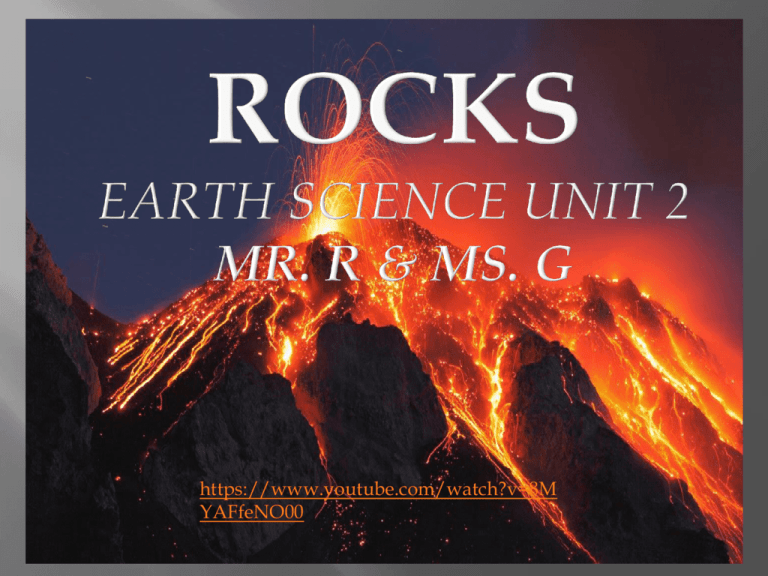Rock Types
advertisement

https://www.youtube.com/watch?v=8M YAFfeNO00 Rocks are any solid mass of mineral or mineral-like matter occurring naturally as part of our planet. Three types of rocks: 1. 2. 3. Igneous Sedimentary Metamorphic Textbook: Pgs 70-85 Find and record the definition of each TYPE of rock Formation: “Mixture of minerals in crystal form and their speed of formation” Intrusive igneous rocks are formed when magma hardens beneath Earth’s surface (inside). Extrusive igneous rocks are formed when lava hardens. This occurs on the surface of the Earth (outside). Cooling Crystallization Consolidation Texture: Crystallization: crystals form from cooling magma, the size of the crystal can vary depending on where and how the magma cools. Fine-grained texture is caused by rapid cooling resulting in smaller, interconnected mineral grains. EXTRUSIVE Coarse-grained texture is caused by slow cooling resulting in larger crystals. INTRUSIVE Glassy – no visible formed EXTRUSIVE crystals Sedimentary rocks may be made of rock fragments—sediments—or by chemical reactions. Sedimentary rocks are products of mechanical and chemical weathering They account for about 5% (by volume) of Earth’s outer 10 miles Contain evidence of past environments • Provide information about sediment transport • Often contain fossils Process from an Igneous or Metamorphic rock into Sedimentary rock: 1. 2. 3. 4. 5. 6. 7. Weathering – mechanical and chemical breakdown of rock to produce sediments Erosion – transportation of sediments from one location to another. Erosion can be a variety of different methods i.e. water, wind, ice and gravity. Deposition – ‘drop’ of sediment on a particular area (land or ocean) Compaction – The layering of sediments in horizontal ‘bedding’ with gravity to produce sedimentary rock layers Cementation – the joining with cement of the individual sediments in the newly formed rock layers. Lithification – Combination of both compaction and cementation Burial – sediments are buried on-top of each other over long periods of time. This is closely linked to deposition Rock types are based on the source of the material Clastic(detrital) rocks – mixture of transported sediment as solid particles. Particle size is used to distinguish among the various rock types Common examples: - Shale - Conglomerate - Sandstone Chemical rocks – sediment that was once in solution Common Examples – limestone, coal and rock salt • • • • • Change of ONE rock INTO ANOTHER rock Formed by heat and pressure changing existing rocks, deeper underground than where sedimentary rocks form; and not too deep to re-melt into magma. REGIONAL METAMORPHIC affects a large area and results from plate tectonics CONTACT METAMORPHISM affects rocks on a local scale, such as “baking” sedimentary rocks next to magma or lava UPLIFT: movement of crust can cause rocks that were once underground to be brought up to the Earth's surface. 2 main types of metamorphic rock: - Foliated Metamorphic Rock Has a banded or layered appearance - Non-foliated Metamorphic Rock Does not have a banded texture Most metamorphic rocks have the same overall chemical composition as the parent rock from which they formed The rock cycle is a process by which magma is cooled and forms igneous rock. The process continues with the transition of different types of rocks on their journey back into magma inside the Earth’s interior. The rock cycle also includes the following cycles: 1. Water cycle 2. Plate tectonics 3. Carbon cycle 4. Weather/climate cycles







